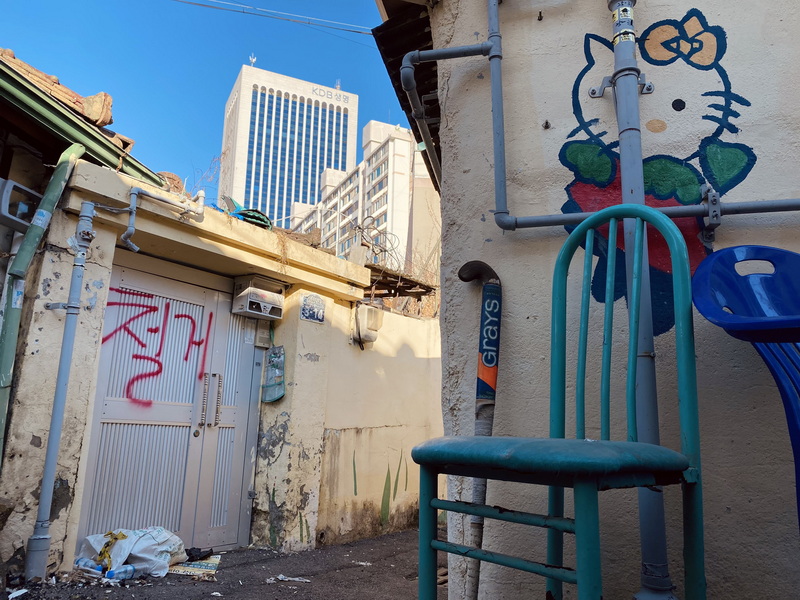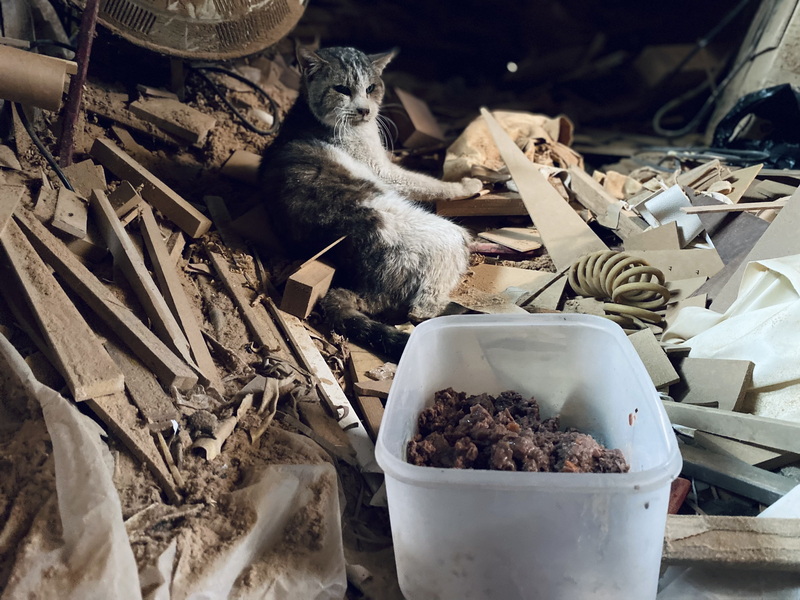Yang-dong’s Ninth Life
By Isaiah Winters
To mark my fifth year stewarding the “Lost” column, I’d like to return to Gwangju proper, specifically Yang-dong. This month, I’ll scribble the pages of the Gwangju News with a tale involving hostess bars, North Korean collages, menacing graffiti, courteous cult invites, and a tenacious cat I call Achilles who, like Yang-dong itself, refuses to die despite all odds.
We begin at Guseong-ro, the winding, two-way street that narrowly separates Yang-dong from Wolsan-dong. Recently, the stalled redevelopment project on the Wolsan-dong side restarted and then promptly jumped the road to gobble up a large block on the Yang-dong side faster than I could notice.
Very little remains of that block in Yang-dong save a trio of hostess bars, one of which is still being lived in. Through a gap in the construction tarp, an older couple goes in and out several times a day, with their vehicle regularly parked right out front. Once they are persuaded to leave, theirs and the adjacent bars flanking either side will surely be rubbled.
Of course, the redevelopment overspill won’t end there. Across Guseong-ro’s perpendicular 57th Street, the next block is almost entirely vacated and ready for demolition, and that’s where things get interesting. Dividing the abandoned block lengthwise is a long, bifurcated alleyway with paragraphs’ worth of findings almost every few meters. For the remainder of this article, we’ll scrape through these claustrophobic walkways together for the first and final time before it’s all gone.

Enter one of the alley forks and the first door you get to, marked “demolition” (철거) in red spray paint, gives way to a collage of newspaper clippings on Supreme Leader Kim Jong-un’s meeting with former President Moon Jae-in. It’s not the usual type of scrapbooking you see every day, so the resident must have been quite moved by this historic event. Apparently, one of the demolition crewmembers was also moved by the meeting, though with the opposite sentiment: He defaced one of President Moon’s pictures.
Further down the alley fork near to where the two prongs meet is another unusual sight, at least in Gwangju. There, an extensive jumble of red, spray-painted messages uglies the facades of vacant homes. Among the menacing scrawls are three red skulls with eyes x-ed out, something I’ve only ever seen in larger cities like Seoul. While the word “demolition” communicates boundaries mainly to those involved with the demolition process, a skull is a far more personal message of intimidation aimed mainly at any holdouts still living in the area.

Down this more heavily graffitied alley is one such holdout. Spilling with belongings all covered in plastic tarp, the door to the home reads rather plaintively, “A person is living here. Please don’t enter.” Here, the alley gets so tapered by personal items that you can almost feel the warmth of whoever lives behind the façade. It’s still possible to complete the alley fork by shimmying through all the personal belongings and emerging back on 57th Street, but most non-residents would feel uncomfortable doing this, which I suspect is by design to keep people out. Using this narrower path to 57th Street also allows the remaining resident(s) to avoid all the ominous graffiti – the blighted cherry atop a neighborhood already in its last, agonal throes.
Despite the cramped interstices with uninviting messages on every wall, locals still use these walkways even now. While photographing a painting of Hello Kitty right at the alley fork, one such local stopped to have a chat with me. Unphased by the large foreigner squatting low for a better shot, the grandma with hand truck in tow seemed to want to know all about me and fast. Midway through our conversation, she whipped out her phone and asked me if I went to church and what my phone number was. We got to talking about her church and, after a little Googling, I saw that it was a cult. Of course, I politely declined, and she was soon back on her way to Yang-dong Market. I’ve already written about my six-week experience learning Korean from this cult, so see my “TOPIK Hoax” article in issue #207 if that interests you.

Behind the Hello Kitty wall is another local holdout – a tenacious cat I call Achilles. Achilles’ hind legs are unfortunately paralyzed, so mobility is very limited. He just lies in the entryway of the home and watches passersby through cracks in the front door. It’s hard to tell whether Achilles’ injury is recent or longstanding, but I’ve noticed that on subsequent visits, he’s been breathing better than when I first saw him. Whenever I’m in the area, I pick up a few cans of cat food and, though it causes Achilles immense distress, enter the home and pour the food into a plastic bowl. He does eat, but I can’t imagine him having much of an appetite with such a bad injury. A bowl of instant noodle soup was also recently placed inside on the floor, so I might not be the only one who knows about him. I can’t believe Achilles has survived this long, so I thought the vulnerable Greek warrior’s name was befitting. If you’d like to do more for Achilles, reach out to me through the Gwangju News or my Instagram account.
Much like Achilles, Yang-dong and its residents are hanging on as long as they can, but this may be their ninth life.
The Author
Hailing from Chino, California, Isaiah Winters is a pixel-stained wretch who loves writing about Gwangju and Honam, warts and all. He’s grateful to have had this opportunity to write for the Gwangju News all these years. More of his unique finds can be seen on Instagram @d.p.r.kwangju and YouTube at Lost in Honam.







